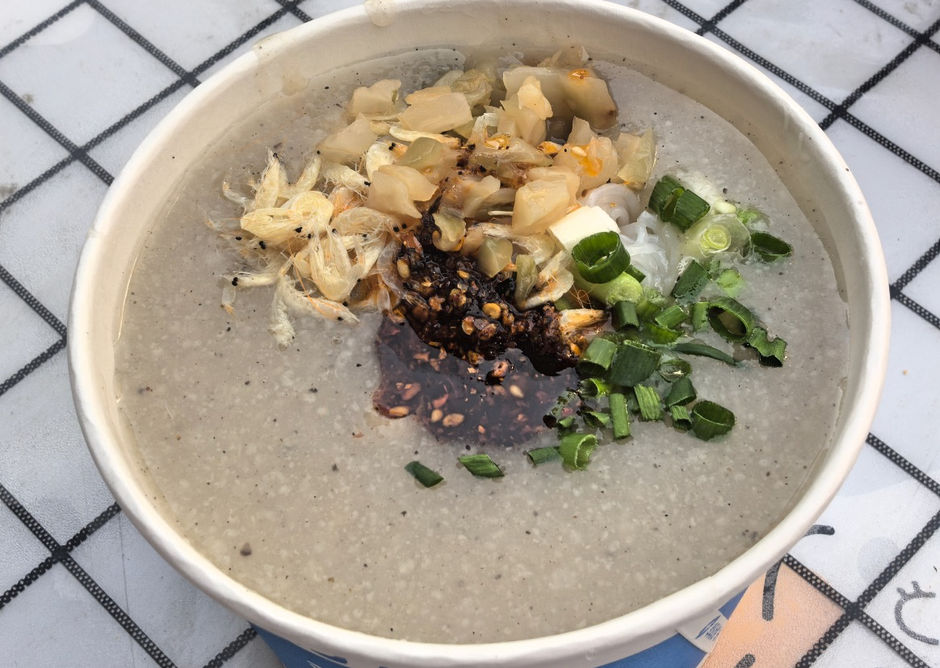Wuhan Food
A Culinary Journey Through Wuhan
Wuhan’s Food Story: Tradition, Innovation, and Flavor
Wuhan, China’s "River City," boasts a vibrant food culture rooted in its Yangtze River heritage and Central China flavors. Famous for its Guozao (breakfast ritual), the city serves iconic dishes like Re Gan Mian (hot dry noodles with sesame sauce), Doupi (crispy tofu-skin pockets), and Mianwo (savory rice doughnuts). As a UNESCO-listed "City of Gastronomy," Wuhan blends ancient recipes like Hutang Fen (fish-broth noodles) with modern street food innovation. Explore bustling markets like Hankou Night Market or book a Yangtze River food cruise to taste history in every bite. From fiery duck necks to lotus root soup, Wuhan’s flavors tell stories of trade routes, wartime ingenuity, and local pride. Perfect for travelers seeking hidden food gems in Central China or foodies craving underrated Asian culinary adventures.
A Culinary Journey Through Wuhan
Wuhan, the city where rivers converge, is renowned for its "Guozao (过早)" breakfast culture. The iconic Reganmian (热干面) takes center stage—alkaline noodles tossed with sesame paste, requiring a precise three-second stir, with 6 million bowls consumed daily; the secret recipe from Cai Linji uses 12 spices. Doupi (豆皮), a golden combination of glutinous rice and egg skin, was perfected at Lao Tongcheng with three-layer fillings for Chairman Mao, achieving a crispy 0.3mm crust. Hutang Fen (糊汤粉) embodies the wisdom of Yangtze fishermen, featuring milky broth from wild minnows paired with crullers, boasting triple the collagen of bird’s nest. Mianwo (面窝), born from repurposed WWII-era American cans, offers a crispy hollow center, now reimagined with shrimp and cheese as a "Hankou-style French pastry."
Tangbao (汤包) from Sijimei dazzles with translucent wrappers holding 25g of chicken broth—sip first via straw. Shaomai (烧梅) seduces with pork, sticky rice, and black pepper, shaped into chrysanthemum blooms by the Yan family. Nuomibao Youtiao (糯米包油条) balances sweet and savory, from classic sesame sugar to modern salted egg floss. Fish Paste Noodles (鱼糊粉), a century-old dockworkers’ staple, blends carp broth and rice slurry, topped with pickled radish. End with Huanxituo (欢喜坨), colossal hollow sesame balls oozing molten brown sugar at Jiqing Street night markets. From dawn to dusk, Wuhan’s cuisine narrates tales of its rivers—every bite a flavorful epic of this江湖 (jianghu) city.
Key Dishes in Wuhan:
Reganmian (热干面) / Doupi (豆皮) / Hutang Fen (糊汤粉) / Mianwo (面窝) / Tangbao (汤包) / Shaomai (烧梅) / Nuomibao Youtiao (糯米包油条) / Fish Paste Noodles (鱼糊粉) / Huanxituo (欢喜坨)
1.Wuhan Hot Dry Noodles (热干面) - A Breakfast Legend with Scientific Precision
The Mind-Blowing Math
A quintessential Wuhan breakfast, Reganmian features alkaline noodles tossed in rich sesame paste, soy sauce, pickled radish, scallions, and chili oil. Despite its "dry" texture, the dish bursts with nutty and savory flavors. Affordable and ubiquitous, it’s enjoyed as breakfast, lunch, or late-night street food.
Every day, Wuhan devours 6 million bowls of this sesame-infused delight. If connected end-to-end, the annual noodle consumption would stretch 1.5 million km - enough to circle Earth 37.8 times or reach the Moon twice!
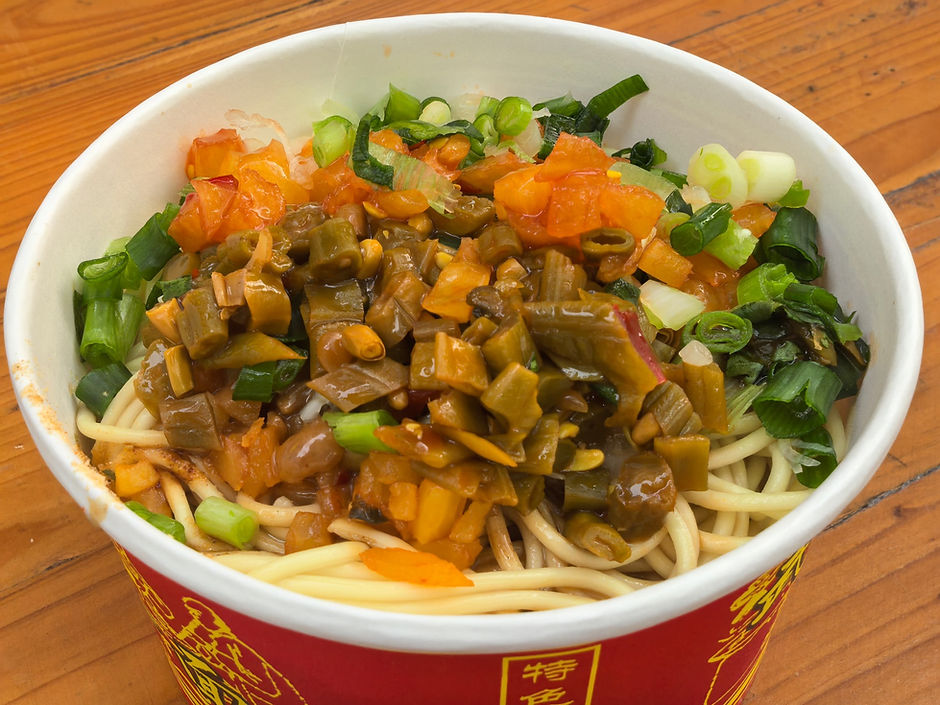
Wuhan Hot Dry Noodles
2. Hutang Fen (Fish-Broth Rice Noodles) / Fish Paste Noodles (Yuhu Fen)
Thick rice noodles swim in a creamy fish broth simmered for hours with carp bones and spices like white pepper. Locals dip youtiao (fried dough sticks) into the soup, creating a comforting blend of spicy, umami flavors. A winter favorite for its warming qualities.
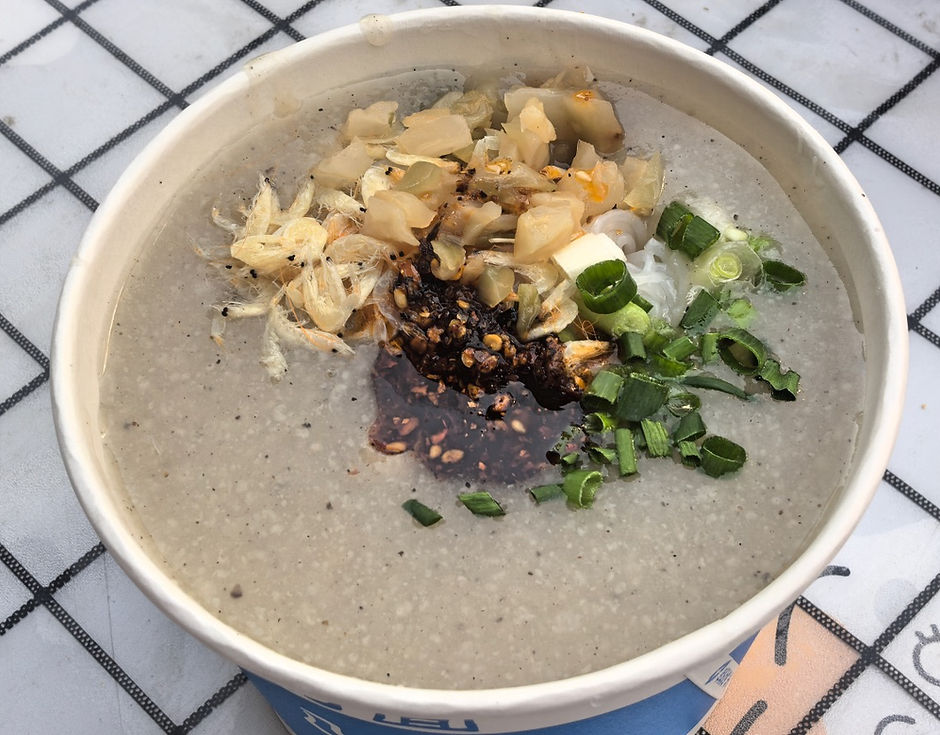
Hutang Fen (Fish-Broth Rice Noodles) / Fish Paste Noodles (Yuhu Fen)
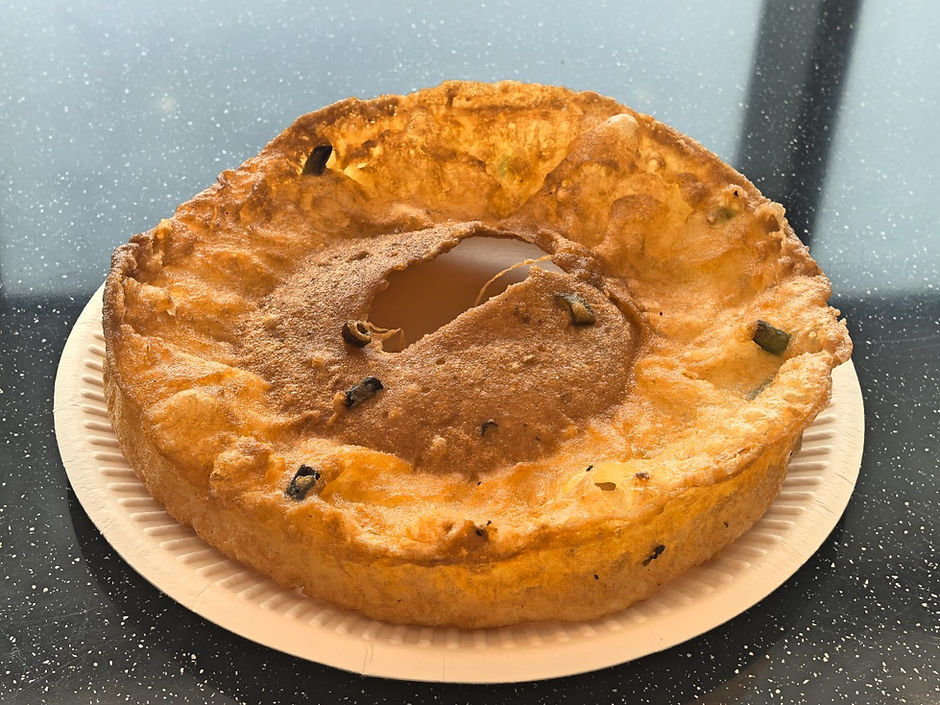
Mianwo (Savory Rice Fritter)
3. Mianwo (Savory Rice Fritter)
This ring-shaped fritter, Mianwo, is deep-fried from a batter of rice and soybeans. Crispy on the edges, chewy in the middle, and hollow at the center, it’s often paired with hot noodles or soy milk for breakfast.
4.Doupi (Pan-Fried Sticky Rice Delicacy)
Doupi is a crispy, golden-brown creation made from a mung bean and rice batter fried with eggs. The crispy shell encases a hearty filling of glutinous rice, diced pork, mushrooms, and bamboo shoots. Invented in the 1930s, this dish balances crunch and chewiness, symbolizing Wuhan’s street food ingenuity.
5. Tangbao (Soup Dumplings)
Wuhan’s Tangbao are oversized soup dumplings filled with pork or crabmeat and a scalding-hot broth. Unlike Shanghai’s xiaolongbao, these require careful eating—some even use straws to sip the rich soup first! Legend ties their origin to the Three Kingdoms era.
6. Shaomai (Hearty Pork and Glutinous Rice Dumplings)
Wuhan’s Shaomai are oil-rich steamed dumplings stuffed with sticky rice, pork, mushrooms, and black pepper. Wrapped in thin dough and crowned with a pork “gem,” they’re a filling breakfast staple.
7. Nuomibao Youtiao (Sticky Rice-Wrapped Fried Dough)
A portable snack, Nuomibao Youtiao layers steamed glutinous rice sprinkled with sugar and sesame seeds around a crispy youtiao. Sweet, salty, and chewy, it’s a textural delight sold by street vendors.
8. Huanxituo (Sesame-Crusted Sweet Rice Balls)
Huanxituo are fried glutinous rice balls coated in sesame seeds, with a crispy shell and soft, sweet interior. Symbolizing joy (hence “Huanxi” meaning “happiness”), they’re a festive treat from late Qing Dynasty folklore.

Doupi (Pan-Fried Sticky Rice Delicacy)

Tangbao (Soup Dumplings)

Shaomai (Hearty Pork and Glutinous Rice Dumplings)

Nuomibao Youtiao (Sticky Rice-Wrapped Fried Dough)

Nuomibao Youtiao (Sticky Rice-Wrapped Fried Dough)
Wuhan Food Strees

Hubu Alley
Hubu Alley (户部巷) – Wuhan’s Breakfast Paradise
Nestled in the heart of Wuhan’s Wuchang district, Hubu Alley is a legendary food street celebrated as the city’s “breakfast capital.” With a history stretching back over 400 years to the Ming Dynasty, this narrow, bustling lane was once a hub for government offices (hubu means “Ministry of Revenue”) and has since transformed into a culinary shrine for locals and travelers alike.
Highlights:
-
Breakfast Heaven: Hubu Alley is synonymous with authentic Wuhan morning eats. Must-try classics include:
-
Hot Dry Noodles (热干面): Wuhan’s iconic sesame-sauce-coated noodles.
-
Sanxian Doupi (三鲜豆皮): Crispy rice pancakes stuffed with glutinous rice, mushrooms, and pork.
-
Huntun (馄饨): Delicate pork-filled dumplings in savory broth.
-
Mianwo (面窝): Crunchy fried rice dough rings.
-
-
Historic Atmosphere: Cobblestone paths, traditional signage, and the aroma of sizzling oil evoke old Wuhan charm. The alley’s layout retains its Ming-Qing architectural vibe, blending nostalgia with modern food stalls.
-
All-Day Indulgence: While famed for breakfast, the street buzzes until evening, offering snacks like stewed duck necks (卤鸭脖) and sweet rice wine balls (糖油粑粑).
-
Cultural Legacy: Known as “the First Alley of Han-Style Breakfast,” it’s a living testament to Wuhan’s culinary traditions. Local institutions like Cai Linji Hot Dry Noodles (蔡林记) and Shi Ji Fried Dumplings (石记煎包) draw loyal crowds.
Tips for Visitors:
-
Go Early: Arrive before 9 AM to avoid crowds and taste the freshest bites.
-
Cash-Friendly: Smaller vendors may not accept digital payments.
-
Try the Combo: Pair Hot Dry Noodles with a bowl of sweet fermented rice soup (米酒).
From dawn till dusk, Hubu Alley offers a flavorful journey through Wuhan’s soul, one bite at a time.

Water Tower Snack Street (Jianghan Road)
Water Tower Snack Street (水塔美食街), Wuhan
Located in the bustling heart of Wuhan’s Jianghan Road district, Water Tower Snack Street is a vibrant culinary hub that captures the essence of the city’s street food culture. Named after the historic Hankow Water Tower (built in 1909), this iconic street blends rich history with modern gastronomic energy, making it a must-visit for food lovers.
Thick rice noodles swim in a creamy fish broth simmered for hours with carp bones and spices like white pepper. Locals dip youtiao (fried dough sticks) into the soup, creating a comforting blend of spicy, umami flavors. A winter favorite for its warming qualities.
Highlights of Water Tower Snack Street
-
Diverse Local Flavors: The street is famed for its authentic Wuhan specialties, such as Hot Dry Noodles (热干面), Soup Dumplings (汤包), and Three Delicacies Bean Skin (三鲜豆皮). It also offers regional Chinese snacks, from spicy Chongqing noodles to sweet Hubei rice wines.
-
Bustling Atmosphere: Open late into the night, the street buzzes with neon lights, sizzling woks, and the chatter of locals and tourists alike. Vendors line the narrow alley, creating an immersive, lively experience.
-
Affordable Indulgence: Most dishes cost under 20 RMB, making it perfect for sampling a wide variety of treats. Popular stalls like Li Ji Cong You Bing (酥脆葱油饼) and Lao Tong Cheng Desserts (老通城甜品) draw long queues.
-
Cultural Fusion: The juxtaposition of the century-old Water Tower and modern snack stalls symbolizes Wuhan’s blend of tradition and contemporary urban life.
Tips for Visitors
-
Visit in the evening to enjoy the lively night market vibe.
-
Bring cash, as some small vendors may not accept digital payments.
-
Pair your snacks with a cup of Bing Tang Liangcha (冰镇凉茶), a local herbal iced tea.
Whether you’re craving fiery street barbecue or delicate desserts, Water Tower Snack Street offers a mouthwatering journey through Wuhan’s culinary soul.

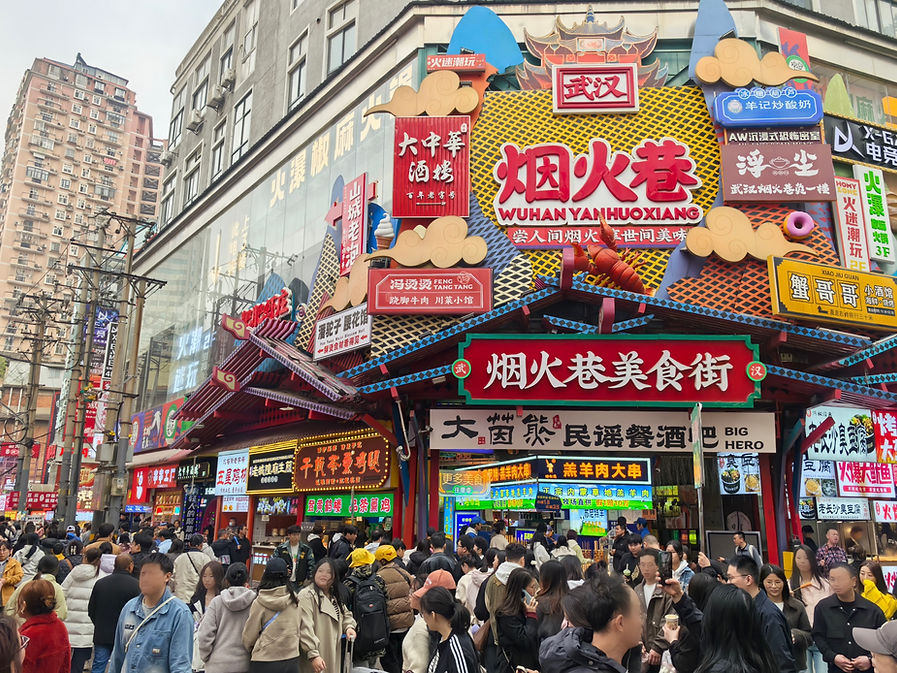
Yanhuo Alley Food Street (Jianghan Road)
Jianghan Road Fire Lane Food Street (江汉路烟火巷美食街), Wuhan
Nestled along the lively Jianghan Road Pedestrian Street, Fire Lane Food Street (烟火巷美食街) is a dynamic culinary destination that celebrates Wuhan’s vibrant street food culture. Combining nostalgic charm with modern flair, this bustling alleyway is a sensory feast where sizzling grills, aromatic spices, and cheerful crowds create an unforgettable experience.
Highlights Jianghan Road Fire Lane Food Street
-
Iconic Wuhan Street Food: Dive into local classics like Stinky Tofu (臭豆腐) with its crispy exterior and pungent aroma, Grilled Crawfish (麻辣小龙虾) drenched in spicy sauce, and Mianwo (面窝), a savory fried rice dough ring. The street also features creative fusion bites, such as cheese-filled rice cakes and rainbow-colored dumplings.
-
Retro-Meets-Modern Vibe: The lane’s decor blends vintage neon signs with trendy murals, reflecting Wuhan’s blend of history and youthful energy. At night, fairy lights and steam from food stalls add a magical glow.
-
Late-Night Hotspot: Open until the early hours, it’s a haven for night owls. Locals flock here post-midnight for post-bar snacks, making it a lively spot to soak up Wuhan’s nocturnal culture.
-
Budget-Friendly Bites: Most dishes range from 10–30 RMB. Don’t miss stalls like Uncle Zhang’s BBQ (张师傅烧烤) for smoky skewers or Sister Li’s Sweet Rice Wine (李嫂甜米酒) for a soothing dessert.
Tips for Visitors:
-
Arrive hungry and ready to explore—the narrow lane is packed with over 50 stalls!
-
Wear casual clothes; the aroma of spices and smoke might linger.
-
Try pairing spicy dishes with Liangfen (凉粉), a cooling jelly dessert, to balance the heat.
From fiery wok-tossed delicacies to whimsical sweets, Fire Lane Food Street embodies the spirited soul of Wuhan’s street food scene.

Wuhan Steamed Crayfish
Wuhan Crayfish (武汉小龙虾) – The City’s Beloved Culinary Icon
In Wuhan, crayfish (小龙虾, xiǎolóngxiā) are more than just a dish—they’re a summer obsession and a symbol of the city’s vibrant food culture. Renowned for their bold flavors and communal dining spirit, these freshwater crustaceans dominate night markets, street stalls, and family gatherings from May to September.
Highlights:
-
Signature Styles:
-
Qīngzhēng Xiǎolóngxiā (清蒸小龙虾): Steamed crayfish served with light soy-ginger dip, highlighting the meat’s natural sweetness.
-
Suānnáo Xiǎolóngxiā (蒜蓉小龙虾): Garlic-lovers’ favorite, smothered in fragrant minced garlic and butter.
-
-
Málà Xiǎolóngxiā (麻辣小龙虾): The classic spicy version, stir-fried in a fiery mix of Sichuan peppercorns, chilies, and garlic.
-
Cultural Phenomenon:
-
Crayfish feasts are a social ritual. Friends gather to crack shells, sip beer, and share stories late into the night.
-
The annual Wuhan Crayfish Festival celebrates this delicacy with eating contests, live music, and innovative recipes.
-
-
Top Spots to Try:
-
Bālí Lóngxiā (巴厘龙虾): A legendary chain famous for its spicy and steamed versions.
-
Zhuàngzhuàng Lóngxiā (靓靓蒸虾): Praised for its fresh, high-quality crayfish and flavorful sauces.
-
-
Affordable Luxury: Prices range from 60–120 RMB per portion (about 1–2 kg), perfect for group sharing.
Tips for Enjoying:
-
Peak Season: June–August offers the plumpest, meatiest crayfish.
-
Hands-On Fun: Don’t shy away from the mess—use gloves (provided) and suck the sauce from the shells!
-
Pairings: Balance the heat with liángpí (凉皮, cold noodles) or bīngzhèn liángchá (冰镇凉茶, iced herbal tea).
From fiery woks to steamy baskets, Wuhan’s crayfish culture is a delicious blend of flavor, friendship, and unapologetic indulgence. 🦞🔥

Wuhan Spicy Crayfish
Spicy Crayfish (麻辣小龙虾, Málà Xiǎolóngxiā) – Wuhan’s Fiery Nighttime Delicacy
A symbol of Wuhan’s vibrant street food culture, spicy crayfish (小龙虾) is a must-try dish that dominates the city’s summer nights. Known for its bold, tongue-tingling flavors and communal dining vibe, this dish has become a culinary icon, uniting locals and travelers over shared platters of bright-red crustaceans.
Highlights:
-
Flavor Profile: The crayfish are stir-fried or simmered in a mouth-numbing sauce blending Sichuan peppercorns, dried chilies, garlic, and aromatic spices. The result is a spicy, savory, and slightly sweet explosion of flavors, with a lingering heat that keeps you reaching for more.
-
Night Market Star: Spicy crayfish is the crown jewel of Wuhan’s ye xiao (夜宵, late-night snack) culture. Bustling open-air stalls and restaurants, like Ba Li Lobster (巴厘龙虾) or Liangliang Steamed Crayfish (靓靓蒸虾), serve heaping portions late into the night.
-
Interactive Dining: Eating crayfish is a hands-on experience—crack shells, suck out juices, and dip meat into sauce. It’s a social ritual often paired with ice-cold beer or pijiu (啤酒).
-
Seasonal Sensation: Though available year-round, summer is peak season, with fresh, plump crayfish at their best. Prices range from 50–100 RMB per person, depending on portion size.
Tips for Enjoying:
-
Adjust the Heat: Ask for wei la (微辣, mild spice) if you’re sensitive to chili.
-
Pair Smartly: Balance the spice with liangpi (凉皮, cold noodles) or mung bean soup (绿豆汤).
-
Embrace the Mess: Wear dark clothes and use disposable gloves (often provided) to avoid stains.
More than just a dish, Wuhan’s spicy crayfish embodies the city’s love for bold flavors, lively nights, and shared joy.
Guide: How to Eat Wuhan Hot Dry Noodles as Forigner
Wuhan hot dry noodles, a signature dish of Wuhan, have their own unique eating customs and nuances that distinguish them from how people in other regions enjoy noodles. Here's a look at the distinct ways to savor this beloved local delicacy:
1. The “Slurping” Difference
People from outside Wuhan often “slurp” (called suō in Chinese) when eating noodles or rice noodles, hence terms like “slurping noodles” or “slurping rice noodles.” However, this approach doesn’t work well for Wuhan hot dry noodles—slurping might splash sesame sauce onto your clothes or face! Once you realize this, you’ll understand why Wuhan’s way of eating hot dry noodles is so particular.
2. Key Ingredients:碱面 (Alkaline Noodles) and 芝麻酱 (Sesame Paste)
- Alkaline Noodles: The noodles must be chewy (jīndào). A firm texture is essential for that satisfying “bite.”
- Sesame Paste: Authentic Wuhan hot dry noodles use sesame paste mixed with pure sesame oil—this forms the foundational flavor.
3. Must-Have Toppings
Two classic toppings are non-negotiable for authentic hot dry noodles:
- Pickled Cowpeas (酸豆角): Tangy and slightly spicy, they cut through the richness of the sesame paste.
- Spicy Radish Cubes (辣萝卜丁): These add a crunchy, fiery kick.
Without these toppings, hot dry noodles lack their “soul.”
4. The Art of Mixing (bàn)
Mixing the noodles properly is make-or-break. Many people find hot dry noodles underwhelming simply because they weren’t mixed well!
- Traditional Style: Authentic hot dry noodles have no broth—they’re meant to be dry. These days, most vendors add a little broth, but if you prefer an extra-dry version, ask for “nothing extra” (mòsi dōu bù fàng).
- Adding Vinegar: For those who like a less dry bowl, add a splash of vinegar. Then, mix slowly while the noodles are still hot, ensuring every strand is coated in sesame paste. The result? Pure deliciousness.
5. A Wuhan Morning Ritual
For Wuhan locals, mornings often start with a bowl of hot dry noodles. It’s not just a meal—it’s a daily tradition. When Wuhan people ask, “Nia们早上过早都吃什么?” (What do you eat for breakfast?), hot dry noodles are always a top answer.
In short, eating Wuhan hot dry noodles is about embracing the chewy noodles, rich sesame paste, zesty toppings, and the careful mixing process. It’s a ritual that blends simplicity with attention to detail—all to create that perfect first bite of the day!
Book a Tour With Us
Unlock Wuhan’s Secrets: Premium Tours with Certified English Guides
Why Choose Our Expert-Led Excursions in Wuhan?
1. "Living Guidebook" Depth
2. Zero Language Barrier
3. Safety Guarantee & Quick Access
4. Hyperlocal Story Weaving
Upgrade Your Trip with One Click:
Don’t just see Wuhan – converse with it through certificated guide who speak it in depth.
Book Now →




2 hr
399人民币
Food & Cuisine in Wuhan: A Taste of Authentic Flavors
Wuhan’s culinary scene is a vibrant mix of bold flavors, unique street foods, and traditional dishes that reflect the city’s rich cultural heritage. From the famous hot dry noodles (reganmian) to savory soups and fresh river delicacies, food lovers will find plenty to satisfy their appetites. Explore bustling markets and cozy eateries where every meal tells a story.
-
Wuhan Food Adventure – Discover local specialties and hidden gems
-
Wuhan Night Markets – Experience the city’s lively evening food scene
-
Must-Sees in Wuhan – Iconic spots to enjoy authentic cuisine
-
Shopping – Find local ingredients and snacks to take home
-
Travel Hacks – Tips for ordering food and dining in Wuhan
Explore more with our food tours, market visits, and cultural experiences that celebrate Wuhan’s delicious flavors.













